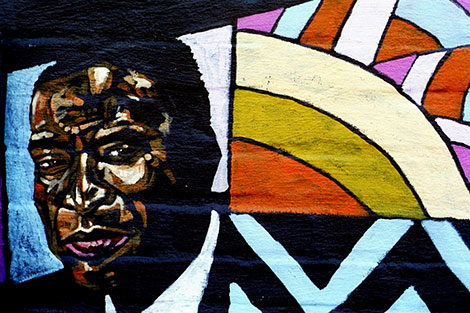
This article was originally published by the Institute for Security Studies (ISS) on 12 April 2017.
Conflict data sources show fewer armed conflicts, but are we getting the full picture?
Political violence in Africa is rising and it is more complex than before. But it is significantly less deadly than in previous decades, according to a number of conflict data sources.
Open-source conflict data is increasingly used to supplement reporting and analysis of trends in instability in Africa. A number of recent global reports, including the OECD States of Fragility 2016: Understanding Violence, use conflict data to show changes in conflict type, actors, tactics and intensity across and within countries over time.
While Africa accounted for only 16% of the global population in 2016, more than a third of global conflict took place here last year. Leading conflict data projects such as the Armed Conflict Location and Event Data Project (ACLED) and the Uppsala Conflict Data Program (UCDP) show that conflict incidents in Africa rose significantly between 2010 and 2014, but have been declining since 2015.
Levels of high-intensity conflicts and wars (where over 500 people are killed) in Africa, as measured by the Center for Systemic Peace and the Heidelberg Institute for International Conflict Research (HIIK), are lower than during the 1990s.
Current armed conflicts in Africa are clustered in four regions: North Africa and the Sahel, West Africa, the Horn, and the Great Lakes region. ACLED reports that between 2010 and 2016, the highest number of politically violent events occurred in Somalia, Nigeria, Egypt, South Africa, Sudan and the Democratic Republic of the Congo (DRC). Across both UCDP and ACLED, in 2015 conflict killed the most people in Nigeria, Somalia, Sudan, South Sudan, Libya and the DRC.
Despite ongoing brutal conflicts since the early 2000s, violence in Africa has been moving away from armed conflicts to higher levels of riots, protests and social violence, such as homicide and violence associated with organised crime. The evidence base for social violence is however weaker – typically drawn from nationally reported homicide statistics. These sources provide little information about for example actor types, tactics and association with criminal gangs, limiting our ability to understand the relationship between political and social violence.
The three-fold increase in ACLED-reported incidents since 2010 is largely explained by the steady rise of protests and riots, spread across the continent as seen in Figure 1 below. South Africa had the highest number of protest events in 2016, followed by Tunisia, Ethiopia and Egypt.
Figure 1: Map of event types, 2010-2016
Source: ACLED, Version 7.0, January 2017.
Remote violence refers to incidents where the tool used doesn’t require physical human presence, for example, improvised explosive devices (IEDs), and mortar and missile attacks. Most battle events were fought in Somalia, Libya and Nigeria.
While these arcs of conflict (North Africa/Sahel, West Africa, the Horn and Great Lakes) seem to hold over time, dynamics within conflicts tend to change, as seen in the rise of remote violence. ACLED reports that Somalia saw the highest number of remote violence incidents in Africa in 2016. IEDs have become ‘the weapon of choice’ for al-Shabaab. Remote violence typically targets civilians, while battle actors target each other.
Civilian targeting is on the rise. According to ACLED, the deadliest incidents of civilian targeting in 2016 occurred in Nigeria and Ethiopia and were carried out by militias and state forces. In many settings, there is also a greater number of conflict agents than before. ACLED reports that there were 66 distinct actors in Libya in 2016, for example – almost twice as many as in 2013.
The types of actors and groups involved in conflicts are also changing. Historically, rebel groups and state forces are the most common actors across Africa, but increasingly, political and communal militias and unidentified armed groups dominate. This shift is indicative of changing motivations. Political militias differ from rebel groups in that they don’t seek to directly overthrow the governing regime.
The HIIK Conflict Barometer 2016 finds that most high- and low-intensity wars are shifting away from coup attempts and power grabs compared to previous years, and the continent is witnessing more ‘violent crises’, which are associated with fewer deaths, refugees and internally displaced persons.
But politically motivated violence is only part of the story. In 2013, the United Nations Office on Drugs and Crime Global Study on Homicide estimated that 31% of global homicides occurred in Africa. So to get the full picture, data is needed on both political/conflict-related violence and criminal violence – a point made by the OECD report and a new report by Rachel Kleinfeld of the Carnegie Endowment for International Peace.
For starters, governments need the capacity to better collect data and regularly release crime statistics. These should be disaggregated by gender and include important information, such as links with organised crime. Different data sources also need to be standardised and made compatible with each other so that they can be compared.
This is necessary, as Kleinfeld points out, if African countries want to achieve the UN’s Sustainable Development Goal to ‘significantly reduce all forms of violence and related deaths everywhere’.
About the Author
Ciara Aucoin is a Researcher for African Futures and Innovation programme at the Institute for Security Studies.
For more information on issues and events that shape our world, please visit our CSS Security Watch Series or browse our Publications.

